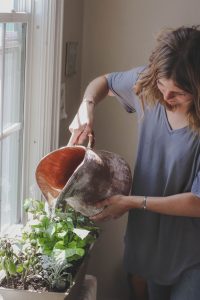Submitted by Guest Blogger, Judith Tamarah, MIARC
 Not enough time to do a self-care practice is frequently looked at as the culprit behind a derailed self-care routine; but I believe the deeper cause is that we haven’t made the space.
Not enough time to do a self-care practice is frequently looked at as the culprit behind a derailed self-care routine; but I believe the deeper cause is that we haven’t made the space.
One of the greatest tools we have is our environment. Our environment, whether home or workspace, holds us emotionally, energetically, and practically. Some environments hold and support certain actions so much that we automatically do them whenever we enter that room. We watch TV in the family room. We knit when we’re in a special chair. Some environments make it difficult to get an action completed no matter how strong our intentions.
Anchoring self-care in your environment.
We can set up our environments to anchor our self-care practices. By creating a place that holds the actions we want, we can give ourselves the emotional and practical support needed to carry out a new routine so it becomes consistent and inevitable.
Below, I outline the process I take my clients through when I help them create nourishing self-care environments. Even though I’ve outlined them as a sequence, these steps often happen a little bit there and a little bit here, as we try on our evolving space and get clearer about our needs.
though I’ve outlined them as a sequence, these steps often happen a little bit there and a little bit here, as we try on our evolving space and get clearer about our needs.
Step One: Chose the self-care practices that are important to you.
What are the self-care actions you want to create space for? Be honest. Say what you really want, not what you think you should do. Do you actually like yoga? Does it make your bones feel good? Or would dance or sleeping a few extra hours nourish you more? Make a list and then eliminate anything that doesn’t make your heart sing. For this exercise choose one self-care practice to start with.
Step Two: Claim space.
Claiming space is the act of taking up space and creating room for your self-care action. It’s both an inner psychological process and an outer practical process. It’s important to do both.
Claiming space starts with an internal decision that you are important and deserve to have the space to take care of yourself. After this internal decision is made, the external process of finding a space in which to do the action is more straightforward. By making this clear internal commitment to take up space we avoid fights with our subconscious, fights that can show up as attempts to squeeze our self-care practice into all sorts of unsuitable corners.
 Step Three: Become clear on the practical needs.
Step Three: Become clear on the practical needs.
After this internal decision is made, you can begin practical logistics. What kind of physical space do you need in order for the action to happen? Do you need a clean, un-obstructed, 10×10 patch of floor space and a door that shuts? What equipment do you need? Do you have yoga blocks and a mat and can they be stored in the yoga space, and not in a closet far, far away? Make a list of the things you need, both the bare bones and the ideal, for the action to successfully take place.
You may end up looking around your house and see nothing that fulfills all your requirements — yet. But starting with a clarity about what you actually need will make finding and creating that space so much easier than having an amorphous sense of needing something and not knowing what it is.
Step Four: Decide how you want it to feel.
Spaces function best when they support us not just functionally, but emotionally and energetically as well. We gravitate to spaces that address our emotions. A 10×10 patch of floor that is dismal and smells like a wet dog won’t motivate us do yoga and won’t anchor our practice with the consistency and ease that we’re after.
to spaces that address our emotions. A 10×10 patch of floor that is dismal and smells like a wet dog won’t motivate us do yoga and won’t anchor our practice with the consistency and ease that we’re after.
Understanding what our emotional needs are and how to translate them into colors, scents, textures, objects, and light is an ongoing and deeply revealing process. For many of us our natural knowing of what we love has been distorted over time by voices that have told us what we ‘should’ want, or what we can’t have. A litany of excuses float through our heads — it’s not important, it’s selfish or frivolous, it’s too big or gaudy, it’s boring, or it’s financially non-essential.
But materials matter. The cells of our brain link the memories of who we are, our identities, with the sensate experience of the world around us. Materials evoke an experience of ourselves as loved, seen, cherished, independent, or powerful.
The practice I describe below is called the noticing practice. You can pick up a more detailed version of it here http://bit.ly/NoticingPracticeGift but the basic approach is as follows.
Ask yourself these questions:
How do I want to feel when I’m doing my self-care practice so that I have the experience I want?
For example, how do you want to feel when you do yoga? Do you want to feel calm, centered, strong, independent, brilliant, or kind? Get specific.
Where have I felt that way before? Where in my life do I feel it right now?
Did you feel independent the first time you had your own apartment? Or when you were traveling through Asia after college? Did you feel calm and free in a backyard treehouse when you were 7? Did you feel seen and cherished in your grandmother’s kitchen when she was teaching you to bake?
 Remember or visit those places and look around you. Notice the colors, textures, scents, and kinds of light that are around you. Use all your senses and start a list of these physical qualities. These are the materials to begin bringing into your self-care environment.
Remember or visit those places and look around you. Notice the colors, textures, scents, and kinds of light that are around you. Use all your senses and start a list of these physical qualities. These are the materials to begin bringing into your self-care environment.
Step Five: Give it time.
Allow yourself the time it takes to change your environment. Not only are you making practical changes, i.e., painting a room, moving things around, etc., which themselves take time and resources, but you are also changing emotional patterns and habits.
The degree to which we have an environment that supports our self-care practices is the degree to which those practices happen. So make a change. Paint a wall the blue of your grandparents’ cottage by the sea, or hang a shawl that reminds you of your trip to India. Then try your new space on and see how it feels. Then make another change. And another. Until it feels just right. This is the process of creating a place that holds us perfectly, easing us with simplicity and grace into routines that nourish us.
Bio:
Judith’s self-care routine includes permission to play hookie and take spontaneous walks. Her work focuses on creating places that hold and nourish your natural way of doing things and feed your soul. She holds a Masters in Interior Architecture from the University of Oregon and is certified in Design Psychology. If you would like more practices and insights to help create nourishing space in your home or workspace, sign up for her newsletter: http://bit.ly/JudithTamarahNewsletter.


